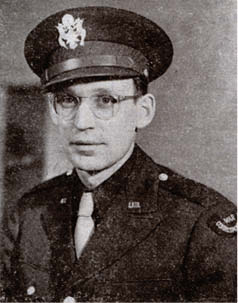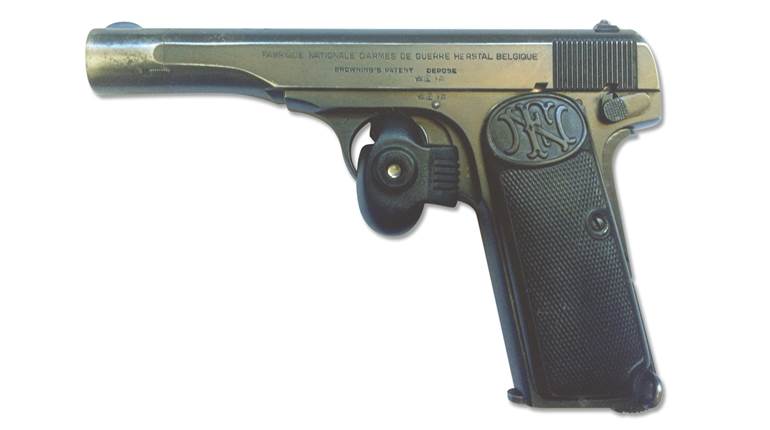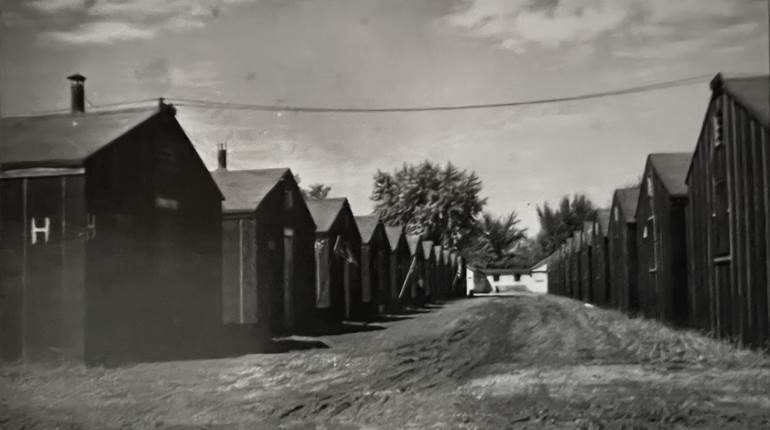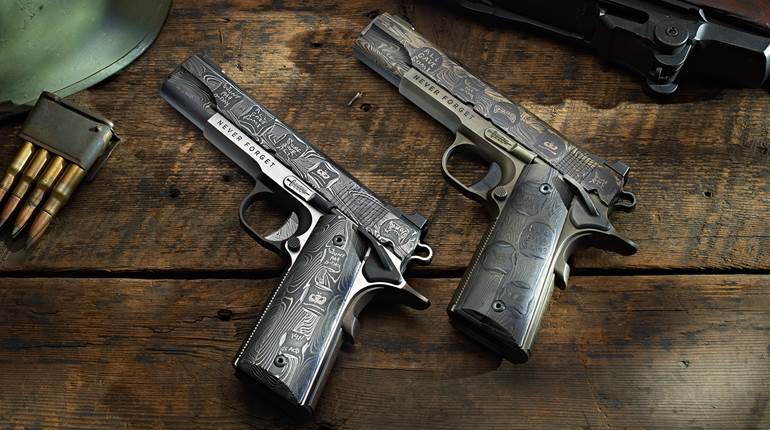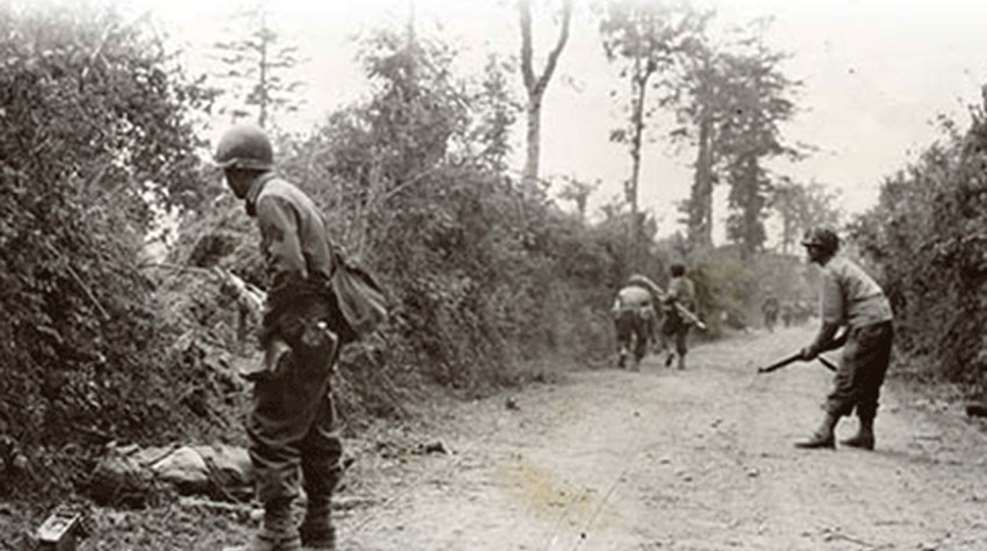
This article was first published in the September 1944 issue of American Rifleman.
With the First Army in Normandy, July 25, 1944
The West Wall of Hitler’s Europe is a hedgerow in Normandy! Or, rather, a succession of hedgerows through which our advance goes yard by yard and field by field, at a cost even greater than that paid for our beach landings.
Don’t confuse the hedgerows of Normandy with the ornamental hedges used to fence off gardens or lawns back home. Maybe the officers who planned this phase of the fighting did just that. They knew that the hedges were here, of course, but it is doubtful if the real defensive possibilities of these hedges were understood. Many a junior officer, some general officers, and a large majority of the enlisted men complain that they were never briefed on the hedgerows and the difficulties they involved. Be that as it may, this fighting here in Normandy hedgerows-is tough!
Officers who have fought in the Pacific say that the fighting here is comparable to that in the jungles, plus the fact that, here, our troops must advance over open fields while the enemy has the advantage of jungle concealment from which he still has clearer fields of fire than are usually to be found in the jungle.
Much has been written about the hedgerow fighting since the Normandy campaign entered into the second or development phase following the establishment of a firm beachhead. It cannot be overemphasized. The initial phase was bitter enough, despite early reports which might have made it appear easy. But the fighting of this second phase is admittedly more bitter at every point, and the casualties higher.
The Germans have been quick to capitalize on the defensive possibilities, have exploited them to the fullest. We are not fighting Germans here exclusively. We are fighting the pre-Napoleon inhabitants of Normandy. It was the early stock grazers, the people who made Normandy the land of dairies and orchards, who added to our difficulties. There was little stone in the fertile fields with which to build fences, so they improvised fences out of the fields themselves by scooping up Earth in long rows, leaving ditches or moats on each side. Along these rows they sometimes planted trees. Whether planted or not, trees grew and were interlaced with undergrowth. Sometimes attempts have been made to keep these hedges trimmed; oftentimes not. The byroads between farms or sections are sunken roads. There are many of them, a regular network so covered over by the high growth of hedge and tree that only a low-slung jeep, at the best, can travel. Picture each such a camouflaged, concealed trench, each hedgerow a parapet, and you will have some conception of the terrain.
One of the first outfits to learn of the almost impenetrable natural defenses was an armored unit which attempted to linkup with the 101st Airborne battling in and around Carentan. The infantry had been well trained in working with tanks, had had experience in Sicily. The joining-up thrust seemed fairly easy. The tanks followed the roads. (Because of the hedges, this was their only course.) The infantry worked the flanks, one or two fields’ depth to each side. Then it was discovered that the enemy was only withdrawing off the roads, circling in the fields farther to each side and coming up on the rear of our troops. The tanks, fearful of getting hit from the rear by the effective German bazookas (almost a replica of ours, but carrying a larger projectile) had to withdraw, well aware now that any offensive would have to cover the countryside, hedge by hedge, irrespective of roads or easy routes. The pattern now is generally similar.
Infantry and tanks keep apace. The infantry protects the tank against enemy infantry with bazookas, or reconnoiters for anti-tank guns. The tanks protect the infantry from machine guns and the enfilading fire of automatic weapons in concealed nests. At first, the tanks were victims of the hedges, diving into the ditches nose first, to be stuck there and become easy targets, or getting suspended on the hedges, nose in the air, unable to bring their guns to bear on the far side. Bulldozers now make the openings for the tanks. If bulldozers are not available, the engineers plant a charge and blow an opening in the hedge. Groups of land mines, three in a group, are set off in a space wide enough for tank entrance.
When the infantry fights it out by itself, it’s the same old story of advance scouts and covering fire from machine guns and rifles as widely dispersed units rush across a field! When the advancing unit is within bayonet rush, the covering fire is lifted to the next hedgerow. If a rifleman gets up to the hedge soon enough, he may get a shot.
Mortars are the old standby and the doughboy’s first love in supporting fire. But even the accurately placed mortar bursts cannot search out every foot of a hedge. Advance scouts can give them the cue on machine-gun emplacements, but the lone German is cleverly emplaced. He is dug into or under the bank that supports the hedge. These dugouts are adaptable to defense of either side of the hedge. By means of an opening large enough to crawl through, no matter from what side the attack may come, Jerry has only to crawl through or under the tunneled bank and he is ready for action again. He has ample protection, observation, and traverse of fire even after a right-about-face.
An indication of the close fighting which oftentimes comes out of hedgerow defenses is in the story told me by S/Sgt. W.L. Maiko, of Colorado Springs, Colo. He’s a rifleman; has five Jerries to his credit, all of them shot out of trees in the earlier advance inland. (The present field-by-field offensive hasn’t allowed much of that type of rifle work.) In this instance, he and his lieutenant were on one side of the hedge, some Germans on the other. The lieutenant stood up to throw a grenade in what he thought was the general direction of the enemy. He was fired on by a German officer with a machine pistol. Maiko saw the movement in the hedge, fired a quick shot and killed the German. Another German started running, giving Maiko a fleeting target beyond the hedge. Maiko grabbed on to parts of the hedge, pulled himself up above it and fired three shots, bringing that German down in what his buddies called a fancy piece of shooting.
There is no exaggeration to the reports of snipers in trees. The Germans have copied the Japanese in that, as they consider this jungle fighting. Any number of riflemen I’ve talked with tell of getting shots at these snipers when their positions were disclosed. The rifle marksmanship of the Americans has caused a marked decline in the popularity of the tree-sniper idea. The hedgerows are much safer and almost as good for observation.
The rifleman, who makes up the large majority of front-line troops on the offensive, must be an all-around hand with small arms, bayonet, hand grenades and rifle grenades. There is, also, the specialist-the stalker and scout who goes looking for trouble-and the sniper who waits patiently in an outpost to pick off enemy mortar or artillery observers, outpost guards or machine gun crews.
Many of the hero stories being written from here concern the stalkers; men with 20 or 30 Germans to the credit of their stealth and their marksmanship. Talk with any of the men who have held any line, even for one day, and you learn how the rifle pays off. Let me give you a few incidents of good shooting typical of the day’s work in the hedgerows:
Private First Class Ray Register, of Slocomb, Ala., was stationed in an outpost of a defensive line. He had his ’03 rifle equipped with telescopic sight, and his binocular. Watching through his glasses, he saw the enemy trying to set up a machine gun at an intersection of the hedgerows. He spotted four Germans busy at their emplacement. He fired four times, almost as fast as he could work the bolt, saw three Jerries go down for sure and believes he also got a hit on the fourth. The distance was approximately 350 yds.
The shooting disturbed the lone German outpost nearer to him. He noticed some rustling along a connecting hedgerow. Waiting and concentrating on that spot, he became quite certain there was a German sniper lying in the ditch on Register’s side of the field, camouflaged and concealed but unable to get to the other, safe, side of the hedge. By this time, Register had been joined by an artillery observer. He asked the observer to spot for him as he fired a shot. Observation proved unnecessary, for his first shot brought a cry from the ditch, a noticeable movement of a body, and then the long silence.
Private First Class Register has been one of his shooting Colonel’s protégés during his more than three years with this particular regiment; three years in which the CO has developed many a sniper the equal of Register. And they have paid off, the Colonel told me, in added interest in marksmanship in the regiment as a whole, as well as in the successes of individual snipers.
Technical Sergeant James R. Foffen, of Staunton, Va., was working along a hedgerow as a scout, in one of the larger fields. He spotted three Germans moving out ahead, trying to sneak along to a safer position behind the next hedgerow. Setting his sights at an estimated range of 400 yds., Foffen fired and knocked one down. The other two stopped to pick up the wounded Jerry and Foffen got in another shot. There were now two wounded Jerries, one evidently able to get away under his own power, the other, by this time, dragged to quick cover by the third German. When our advance caught up, the man first wounded was still there.
Sergeant H. Carrington, of Juniper, Ga., a slight, sandy-haired youngster who has done “a lot of shooting with shotgun and rifle all my life,” had to wait until long after D-Day before getting his first shot at Jerry. This German silhouetted himself perfectly on the crest of a hill, evidently unaware of any Americans in his area. It was a medium-range shot, about 300 yds., but a neat one. Currington just took his time, as he explained, got into a comfortable kneeling position and fired. The German went down without a struggle, not even a spin. Later Currington found that the shot was a heart shot, “right where I held on him.”
Another time, Currington was effective without the deliberation. His advance patrol flushed out two Germans. He got a quick shot at one just as the German neared another hedge … saw the other one go down as if hit, also. When his men came up on these two, they found one dead from the one shot, the other one just scared and lying there mumbling in broken English: “Look, my poor Kamerad, my poor Kamerad.” He was glad to be taken back through the lines.
These are the stories you pick up around the G.I.s. Any one of them will tell about another, not about himself. The longer shots seem to stand out in their minds whenever you mention good shooting. There are not many heroes; they’ve been too busy fighting up to this time to build up the legends. But in every case there are samples of outstanding work, samples like those given above. Those samples will grow in number, and then you have the heroes and the legends. Meanwhile, they’re all doing their job as they have been taught-and most of that teaching is the good old American doctrine of accurate shooting-whether with rifles, BARs, machine guns, rifle grenades or bazookas.
